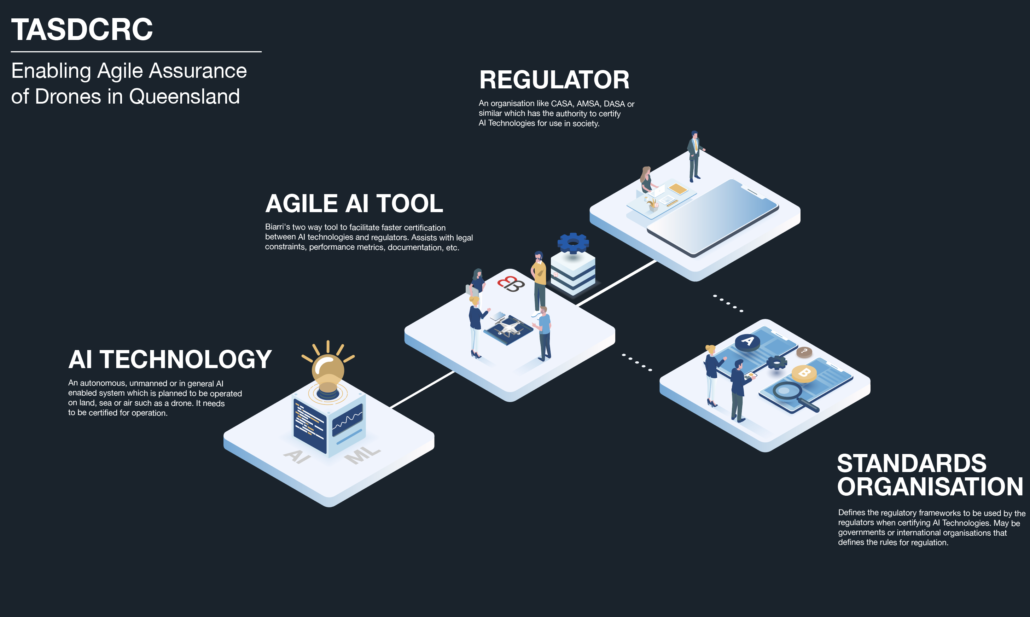Assuring Automation Smarter

In identifying the key disruptive technologies of the future, drones appear on most major industry assessments as a top disrupter. Around the world, countries are scrambling to lead these developments with Queensland and Australia leading innovators and investors in drones, robotics and autonomous systems. Applications for drones exist in industries such as offshore energy, defence and science for “dull, dirty, dangerous and distant” operations. Independent industry research estimates the global drone market is expected to grow to $100 billion by the end of 2020.
But there is a problem.
The problem is that current assurance and certification processes are not well suited to unmanned systems and can take many months or even years. Coupled with low sales volumes, uncertainty and delays can significantly stifle growth and adoption. The accreditation of robotics and autonomous systems is done on a case by case basis and often by exception rather than streamlined.
To address this challenge, Biarri, Queensland University of Technology (QUT) and the Trusted Autonomous Systems Defence Cooperative Research Centre (TASDCRC), with financial support from Advance Queensland (the TASDCRC and this project receives funding support from the Queensland Government) and domain input from QinetiQ and Australian regulatory authorities, are designing software tools to accelerate and simplify the assurance and certification process for AI enabled and unmanned systems. These types of software tools have recently revolutionised many other industries and so the timing is right to accelerate innovation in the regulation industry via digital transformation.
By enabling faster and more efficient assurance and accreditation processes, our platform will facilitate innovation in a way which will catalyse the next wave of autonomous systems to solve large scale global challenges.
Why Now?
AI and autonomy are introducing new challenges for regulators, insurers, technology developers and system operators – with current methods, policies and practices lagging behind technical advances. Regulatory frameworks in Australia for domains like air and sea represent a mostly static, top-down regulatory compliance model of a public authority regulating under a legislative scheme.
As companies try to certify their new unmanned autonomous systems, facing uncertainty and lengthy delay, it is clear that we require new approaches to assuring land, maritime and air based pilotless vehicles, vessels and aircraft that are sustainable and effective. Owners and operators need to be able to update software and hardware to meet changing operational and regulatory requirements on the fly and not have to resubmit their systems for regulatory reapproval when they do.
The tools that will address this are part of the #RegTech digital transformation, which is based on changing the regulation processes via third generation computational regulatory regimes using digital technologies within digital environments. Such systems already exist in the finance industry, e.g. regulatory sandboxes established for fintech innovators (Allen, 2019; Piri, 2019).
A similar, flexible regulatory environment to what has been done in fintech and the supporting tools will enable the faster assurance and certification of aircrafts, vessels and vehicles driving greater innovation without compromising safety. Although potentially game-changing, building digital and physical sandboxes to work within traditional state-centred regulation is difficult and so it requires the specialised skills – skills which Biarri and QUT, in combination with its project partners, will bring to this endeavour.
What is the goal?
This project is seeking to answer the above challenges by bringing together world leading expertise from a number of partners such as Biarri and QUT’s Faculty of Law as well as experts in the appropriate regulatory environments via the TASDCRC. The goal is to create an integrated system of agile regulatory methods and AI audit tools, in order to simplify and streamline the interaction between the regulator and the regulated. These tools will dramatically shorten the current time it takes to assure and accredit unmanned systems, without compromising trust or safety, therefore providing a high level of value for businesses who need to quickly prototype unmanned systems that incorporate AI core capability.
This two-sided digital platform will also enable the operational parameters and software of unmanned autonomous systems to be rapidly adapted in response to changes in regulatory, legal, ethical and societal needs. The developed software will accelerate innovation and positive commercial outcomes by lowering the barrier to deployment for companies developing unmanned autonomous systems – without compromising trust and safety.
Anticipated Outcomes and Benefits
We expect there to be a number of benefits from the new digital platform. They include:
● World leading capability to deliver faster product development lifecycles for companies to safely test AI enabled unmanned autonomous systems.
● A world-first two-sided digital tool that integrates regulators with the regulated to increase the speed for organisations to reach a safe and trusted deployable state.
● A digital toolkit to allow the auditing and tracking of autonomous and AI based developments and simplification of reporting requirements for companies.
With these benefits Australia has the potential to lead the way in defining and benefitting from the billions of dollars of investments and commercial activities around autonomous systems.

